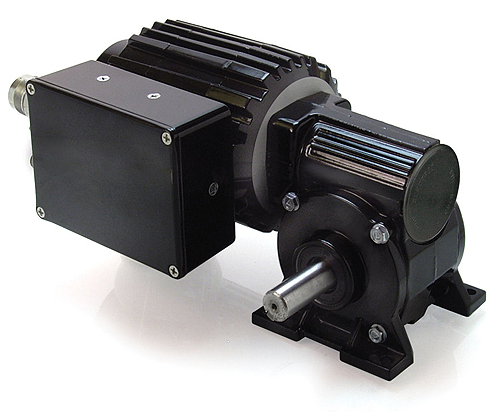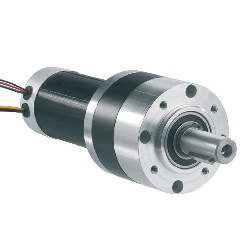
Updated June 2020. || Brushless dc (BLDC) motors are DC motors that use magnets instead of brushes and a commutator for commutation. The benefit to that is they don’t suffer from brush wear … but the drawback is that they need electronic current-phase commutation.
In short, brushless DC motors work like shunt-wound motors, but field flux comes from magnets instead of current through a winding. The permanent magnets are made of rare-earth elements such as high-energy neodymium that generate a magnetic field.
Note that there are some naming-convention caveats: There exist permanent-magnet (PM) DC motors with brushes (for mechanical commutation), and some references call these motors PMDC motors.
Furthermore, motors called brushless DC motors have permanent magnets (PMs), so they are technically PM synchronous motors that run on AC (though through a DC bus and electronic inverter circuitry). In other words, this naming convention merely indicates that 1) these motors don’t run directly from AC lines and 2) the motors (with the proper drives) can replace DC brush motors (paired with drives) in closed-loop applications.
Because of this technicality, some engineers argue that the term “brushless DC motor” is a misnomer that the industry should retire.
Most permanent-magnet DC motors drive fractional-horsepower applications, though other uses are on the rise. Output torque is proportional to armature (rotor) current over the motor’s speed range.
PM motors are smaller, lighter, and more economical to run than many brush motors.
Though brushless DC motors with armature (stator) magnets exist (powered by current to the rotor through a commutator) PM motors with rotor magnets are far more common. These have rotor PMs that form a magnetic field to act much like shunt-wound motors. With the ever-falling cost of electronics, today’s permanent-magnet motor-drive systems are often less costly than comparable brush-motor-drive systems.
Read the related article detailing the effect of pole counts and controls: Motor breeds are smart, connected, and compact
Quick DC and BLDC motor review
Read the related article: What are DC Motors, and How do Definitions Vary? Technical Summary for Engineers
All dc motors generate a magnetic field, either via electromagnetic windings or permanent magnets. An armature, which is often a coil of wires, is placed between the north and south poles of a magnet. When current flows through the armature, the field produced by the armature interacts with the magnetic field from the magnets and eventually generates a torque and thereby motion.
For motion-control applications, the most common dc motor types are brushed dc motors and brushless motors … permanent-magnet motors.
Read the related article: Better ways to commutate BLDCs
Comparison of two dc motor types
In a brushed dc motor, the magnet acts as the stator. The armature is integrated onto the rotor and a commutator switches the current flow. The commutator’s function is to transfer current from a fixed point to the rotating shaft. Brushed DC motors generate torque straight from the dc power supplied to the motor by using internal commutation, fixed permanent magnets, and rotating electromagnets.
Brushed dc motors have the advantage of generally low initial cost and simple control of motor speed. However, there are some drawbacks. At certain periods during the DC motor rotation, the commutator must reverse the current, causing reduced motor life due to arcing and friction. Consequently, brushed DC motors require more maintenance such as frequently replacing the springs and brushes which carry the electrical current, as well as replacing or cleaning the commutator. These components are important for transferring electrical power from outside the motor to the spinning coil windings of the rotor inside the motor.
BLDC motors, on the other hand, do away with mechanical commutation in favor of electronic commutation. That eliminates the mechanical wear and tear involved with brushed dc motors.
In BLDC motors, the permanent magnet is housed in the rotor and the coils are placed in the stator. The coil windings produce a rotating magnetic field because they’re separated from each other electrically, which enables them to be turned on and off. The BLDC’s commutator doesn’t bring the current to the rotor. Instead, the rotor’s permanent magnet field trails the rotating stator field, producing the rotor field.
Successful commutation relies on precise rotor-position data, often from magnetic sensing with a Hall Effect sensor, which also allows for tracking of speed and torque.
BLDC motors have quite a few advantages over their brushed counterparts. Compared to brushed dc motors, BLDC motors are more efficient due mainly to the elimination of the friction from the brushes. They’re also more reliable and typically have longer life spans as well. Getting rid of the brushes also means a decrease in EMI (electromagnetic interference) noise and no sparking from the brushes making contact with the commutator.
Some servomotor systems use brushless dc motors instead of other types of motors (either a brushed DC motor or an AC motor such as an induction motor.)
BLDC motors are used in everything from low-power applications such as consumer products to high power applications in electric vehicles and industrial equipment.



Leave a Reply
You must be logged in to post a comment.